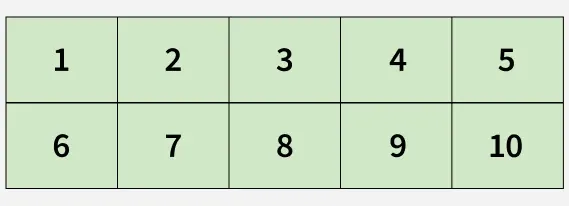Basics of NumPy Arrays (original) (raw)
Last Updated : 06 Dec, 2025
NumPy stands for Numerical Python and is used for handling large, multi-dimensional arrays and matrices. Unlike Python's built-in lists NumPy arrays provide efficient storage and faster processing for numerical and scientific computations. It offers functions for linear algebra and random number generation making it important for data science and machine learning.
Types of Array
Various types of arrays are as follows:
1. One Dimensional Array
A one-dimensional array is a type of linear array.

One Dimensional Array
**Example:
Python `
import numpy as np
a = [1, 2, 3, 4]
arr = np.array(a)
print("List in python : ", a)
print("Numpy Array in python :", arr)
`
**Output:

One Dimensional Array:
Check data type for list and array:
Python `
print(type(list_1))
print(type(sample_array))
`
**Output:

Check data type
2. Multi-Dimensional Array
A Multi-Dimensional Array is an array that can store data in more than one dimension such as rows and columns. In simple terms it is a array of arrays.
For example a 2D array is like a table with rows and columns where each element is accessed by two indices: one for the row and one for the column. Higher dimensions like 3D arrays involve adding additional layers.

Two Dimensional Array
**Example:
Python `
import numpy as np
list_1 = [1, 2, 3, 4] list_2 = [5, 6, 7, 8] list_3 = [9, 10, 11, 12]
sample_array = np.array([list_1, list_2, list_3]) print("Numpy multi dimensional array in python\n", sample_array)
`
Output
Numpy multi dimensional array in python [[ 1 2 3 4] [ 5 6 7 8] [ 9 10 11 12]]
**Note: use [ ] operators inside numpy.array() for multi-dimensional.
Parameters of a Numpy Array
**1. Axis: Axis of an array describes the order of the indexing into the array.
Axis 0 = one dimensional
Axis 1 = Two dimensional
Axis 2 = Three dimensional
**2. Shape: Number of elements along with each axis and is returned as a tuple.
**Example:
Python `
import numpy as np sample_array = np.array([[0, 4, 2], [3, 4, 5], [23, 4, 5], [2, 34, 5], [5, 6, 7]])
print("shape of the array :", sample_array.shape)
`
Output
shape of the array : (5, 3)
**3. Rank: Rank of an array is simply the number of axes or dimensions it has.
One-dimensional array has rank 1.

Rank 1
Two-dimensional array has rank 2.

Rank 2
**4. Data type objects (dtype): Data type objects (dtype) is an example of numpy.dtype class. It describes how the bytes in the fixed-size block of memory corresponding to an array item should be interpreted.
**Example:
Python `
import numpy as np
sample_array_1 = np.array([[0, 4, 2]])
sample_array_2 = np.array([0.2, 0.4, 2.4])
print("Data type of the array 1 :", sample_array_1.dtype)
print("Data type of array 2 :", sample_array_2.dtype)
`
Output
Data type of the array 1 : int64 Data type of array 2 : float64
**Different Ways of Creating Numpy Array
1. numpy.array()**:** Numpy array object in Numpy is called ndarray. We can create ndarray using thisfunction.
**Syntax: numpy.array(parameter)
**Example:
Python `
import numpy as np
arr = np.array([3,4,5,5])
print("Array :",arr)
`
2. **numpy.fromiter(): The fromiter() function create a new one-dimensional array from an iterable object.
**Syntax: numpy.fromiter(iterable, dtype, count=-1)
**Example:
Python `
import numpy as np
var = "Geekforgeeks"
arr = np.fromiter(var, dtype = 'U2')
print("fromiter() array :", arr)
`
Output
fromiter() array : ['G' 'e' 'e' 'k' 'f' 'o' 'r' 'g' 'e' 'e' 'k' 's']
3. **numpy.arange(): This is an inbuilt NumPy function that returns evenly spaced values within a given interval.
**Syntax: numpy.arange( start , stop, step , dtype=None )
**Example:
Python `
import numpy as np
np.arange(1, 20 , 2, dtype = np.float32)
`
**Output:
array([ 1., 3., 5., 7., 9., 11., 13., 15., 17., 19.], dtype=float32)
4. **numpy.linspace(): This function returns evenly spaced numbers over a specified between two limits.
**Syntax: numpy.linspace(start, stop, num=50, endpoint=True, retstep=False, dtype=None, axis=0)
**Example:
Python `
import numpy as np
np.linspace(3.5, 10, 3, dtype = np.int32)
`
**Output:
array([ 3, 6, 10], dtype=int32)
5. **numpy.empty(): This function create a new array of given shape and type without initializing value.
**Syntax: numpy.empty(shape, dtype=float, order='C')
**Example:
Python `
import numpy as np
np.empty([4, 3], dtype = np.int32, order = 'f')
`
**Output:

numpy.empty()
**Note: The output will be randomly generated array.
**6. **numpy.ones(): This function is used to get a new array of given shape and type filled with ones (1).
**Syntax: numpy.ones(shape, dtype=None, order='C')
**Example:
Python `
import numpy as np
np.ones([4, 3], dtype = np.int32, order = 'f')
`
**Output:

numpy.ones()
7. **numpy.zeros(): This function is used to get a new array of given shape and type filled with zeros (0).
**Syntax: numpy.ones(shape, dtype=None)
**Example:
Python `
import numpy as np np.zeros([4, 3], dtype = np.int32, order = 'f')
`
**Output:

numpy.zeros()
As we move forward NumPy will remain an important tool for efficient data manipulation and mastering its core concepts will helps us to solve more complex computational challenges in the future.
What is a NumPy array mainly used for?
- Text editing
- Drawing images
- Storing and processing numeric data
- Managing websites
Explanation:
NumPy arrays help in storing and working with large numeric data efficiently.
Which function is used to create a NumPy array?
- array()
make_array()- np.array()
- new.array()
Explanation:
We use np.array() to create a NumPy array from a list or other data structure.
Which of these is a valid 2D NumPy array?
- np.array([[1, 2], [3, 4]])
- np.array([1, 2, 3])
- np.array(5)
- np.array([‘a’, ‘b’])
Explanation:
A 2D array has rows and columns like a matrix.

Quiz Completed Successfully
Your Score : 2/3
Accuracy : 0%
Login to View Explanation
1/3
1/3 < Previous Next >